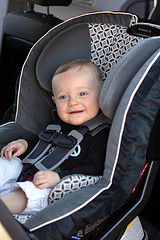Safety is Only a Click Away
Sharing is caring!
National Child Passenger Safety Week (September 14-20) is dedicated to ensuring you know exactly how to keep your little ones safe on the road.
Keeping children safe is an important part of parenthood. Unfortunately, people don’t always consider passenger safety a top priority. In fact, 1 in 4 parents say that they have driven with their child unrestrained and many don’t know that children should ride in the back until at least age 13. Did you know that motor vehicle crashes are the leading cause of death among kids 1 to 19? By simply learning how to correctly use car seats, you can reduce your child’s risk of death by as much as 71%. Car seats and seat belts are effective ways to ensure your child’s safety; however, it’s up to every parent to know how to properly install and use these devices.
Car Seat Safety
More than 70% of car seats are not used or installed correctly, and most parents don’t even realize it! If you don’t know how to install a car seat, Safe Kids hosts child safety seat check events across the nation where technicians teach you to how to properly install and use them. Find a child safety seat check near you by visiting www.safekidsgeorgia.org. Remember that car seats have an expiration date of about 6 years and you should only buy one if you know it’s full crash history. You can use this checklist to ensure your car seat is as safe as possible.
Car Seats: Rear-facing vs. forward-facing
Car seats have changed dramatically over the last decade, so it’s important to know which kind is right for your child. All car seats should always be kept in the back seat away from air bags. Keep your baby in a rear-facing car seat for as long as possible, usually until about age 2. Kids who ride in rear-facing seats have the maximum protection for the head, neck, and spine. You can find an exact height and weight limit on the back or side of your seat.
At age 2, children usually outgrow a rear-facing seat and can graduate to a forward-facing seat. Make sure to attach the top tether after you tighten and lock the seat belt or lower anchors. Kids can remain in forward-facing seats until they’re 65 to 80 pounds. Check the seat label to find the exact measurements. Cease use of the lower anchors or top tether when your child reaches the limits set by your seat and car manufacturers. Read the manual to find those limits.
Booster Seat Safety
Children who have outgrown their car seats, usually around age 5, should transition to a booster seat that enables an adult seat belt to fit properly. Children that sit in booster seats in the back are 45% less likely to be injured in a crash than those only using a seat belt, so it is important to never allow your kids to skip the booster seat phase. In Georgia, the law states that children must use a booster seat until they are either 8 years old or 4 feet, 9 inches tall. When your child is seated in a booster, make sure the lap belt fits low across the hips and the shoulder belt fits across the shoulder. Never place the shoulder belt under the child’s arm or behind the child’s back.
Use a booster seat with the vehicle lap AND shoulder safety belts until your child passes this Safety Belt Fit Test:
- The knees should bend at the edge of the seat when both the back and bottom are against the vehicle seat back.
- The lap belt should fit across the upper thighs.
- The shoulder belt should fit across the shoulder and chest. Children are usually between 8 and 12 years old when the seat belt fits them properly.
Seat Belt Safety
In 2012, safety belts saved more than 12,000 lives! Once your children pass the Safety Belt Fit Test, teach them the importance of wearing them every time they get in a car. Compared with other age groups, teens have the lowest rate of seatbelt usage; so instilling this habit at a young age is vital because it’s more likely that they will continue to buckle up as they get older. Adults should set a good example and always wear a seat belt, because buckling up on every ride is the single most important thing a family can do to stay safe in a car. Remember not to let kids slouch or lean against windows in the car. Sitting up straight is the safest way to travel.
Join us on Facebook



